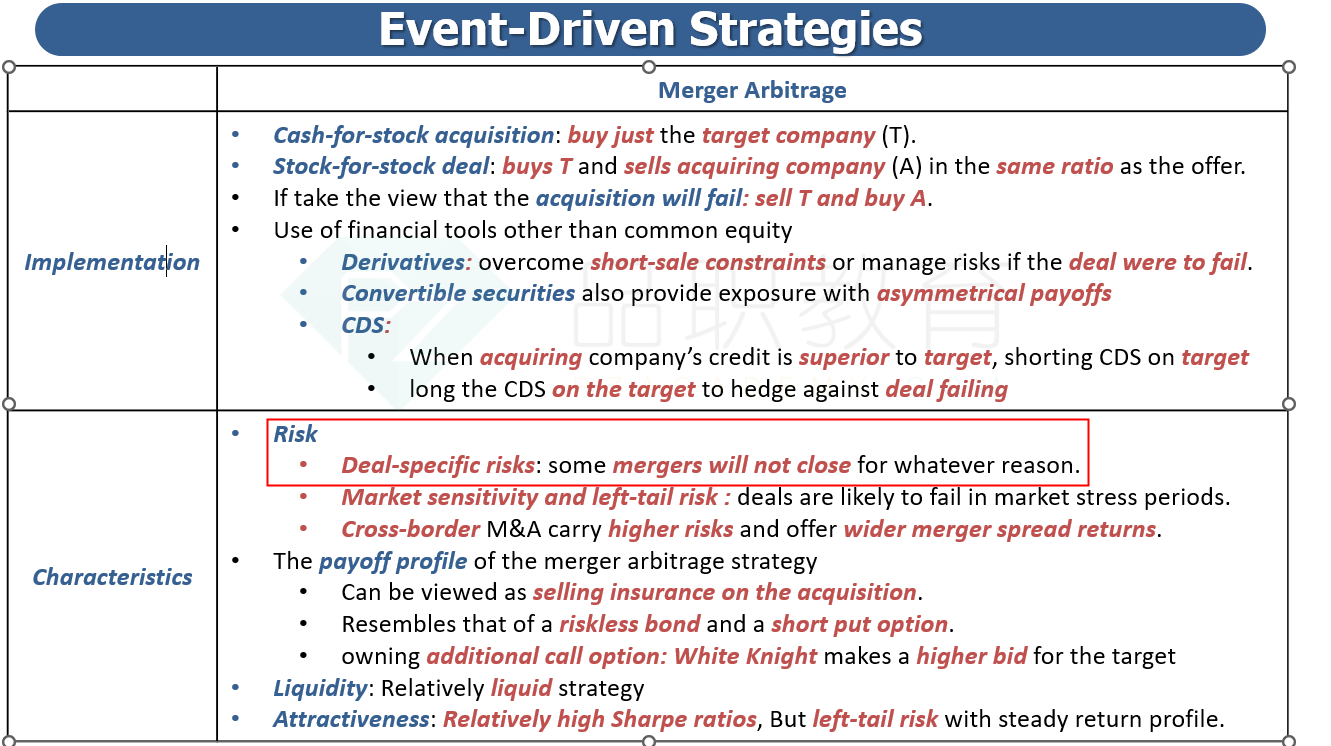NO.PZ201909280100000903
问题如下:
Which of the following
set of derivative positions will most likely satisfy the IC’s
concern about the event-driven strategy involving AA and TT?
选项:
A.Long out-of-the-money puts on AA shares and long out-of-the-money calls on TT shares B.Long out-of-the-money calls on AA shares and long out-of-the-money puts on TT shares C.Long risk- free bonds, short out- of- the- money puts on AA shares, and long out-of-the-money calls on TT shares解释:
B is correct. The
event-driven strategy that Mukilteo researches is a stock-for-stock merger
arbitrage strategy. In this strategy, because the management of the acquiring
company (AA) believes its shares to be overvalued, it will offer AA shares in
exchange for target company (TT) shares in a specified ratio. The merger
arbitrage fund manager will then buy TT shares and sell AA shares in the same
ratio as the offer, hoping to earn the spread on successful deal completion.
For most
acquisitions, the initial announcement of a deal will cause the target’s share
price to rise toward the acquisition price and the acquirer’s share price to
fall (either because of the potential dilution of its outstanding shares or the
use of cash for purposes other than a dividend payment). If the acquisition is
unsuccessful, the manager faces losses if the target’s share price has already
risen and/or the acquirer’s share price has already fallen in anticipation of
the acquisition. When merger deals do fail, the initial price rise of the
target’s shares and the initial price fall of the acquirer’s shares are
typically reversed. Arbitrageurs who jumped into the merger situation after its
initial announcement stand to incur substantial losses on their long positions
in the target’s shares and their short positions in the acquirer’s shares.
To manage the risk of
the acquisition failing, the manager can buy out-of-the-money calls on AA
shares (to cover the short position) and buy out-of-the money puts on TT shares
(to protect against loss in value). Such a position will provide protection
that would likely satisfy the IC’s concern about losses with this strategy.
A is incorrect
because protecting against loss with this strategy requires buying
out-of-the-money calls (not puts) on AA and buying out-of-the-money puts (not
calls) on TT.
C is incorrect
because it represents the payoff profile of this merger arbitrage strategy, not
a way to protect the strategy against loss should the acquisition fail. The
payoff profile of this merger arbitrage strategy resembles that of a riskless
bond combined with a short put option on AA shares and a long call option on TT
shares. The short put on the AA shares reflects the need to cover the short
position in AA when the share price rises. The long call on TT shares becomes
valuable if and when another interested acquirer (i.e., White Knight) makes a
higher bid for TT before the initial merger proposal is completed.
事件驱动策略是一种股票对股票的并购套利策略。在该策略中,由于收购公司(AA)的管理层认为其股票被高估,它将以特定比例提供AA股份以换取目标公司(TT)的股份。并购套利基金经理随后将按照与要约相同的比例买入TT股票并卖出AA股票,希望在交易成功完成后赚取价差。
对于大多数收购而言,交易的最初宣布将导致目标公司的股价朝着收购价格上涨而收购方的股价下跌(因为其流通股可能被稀释或将现金用于非收购目的)股息支付)。如果收购不成功,如果目标公司的股价已经上涨和/或收购方的股价因预期收购而下跌,则管理人将面临损失。当合并交易确实失败时,目标公司股票的初始价格上涨和收购方股票的初始价格下跌通常会逆转。在首次宣布合并后进入合并情况的套利者,他们在目标公司股票中的多头头寸和在收购方股票中的空头头寸可能会遭受重大损失。
为了管理收购失败的风险,基金经理可以购买 AA 股票的虚值看涨期权(以保护空头头寸)并购买 TT 股票的虚值看跌期权(以防止TT公司价值损失) )。这样的头寸将提供保护,可以满足对这种策略的损失的担忧。
正常而言不是应该buy target, sell acquiring company吗?





